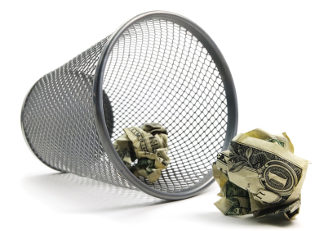The Wobbly State of Chinese Banks
China’s banks have grown to nearly three times the country’s GDP, a fact that has some experts worried that the entire financial system is on the verge of collapse. If China is forced to dip into its foreign capital reserves to rescue its banks it could substantially depreciate the already-dodgy yuan.
In the dry, stuffy parlance of economists, ratings agency Moody’s assessment is stark and paints a picture of increasing risks for Chinese banks going forward. The main concern is “asset quality” which is an economics euphemism for sketchy loans. China’s expansion and growth was driven by a combination of infrastructure investments and loans to businesses to expand factories and manufacturing capacity. As the Chinese economy continues to slow more and more of those loans will go bad.
Kyle Bass, one of the people who made billions by accurately the U.S. housing collapse, is now looking at Chinese banks as the world economy’s next trouble spot. He’s betting billions that the Chinese yuan will depreciate and not by a little. He’s guessing the yuan could drop by thirty or forty percent, sparking another global recession.
Sound Familiar?
It shouldn’t be too hard for Americans to grasp the concept of how a few bad loans can cascade into a full-blown meltdown, we’ve been to that rodeo before and the math is brutal. Chinese banks have eleven trillion in assets and loans that reach into nearly every aspect of Chinese business. On the other side of the scale China currently has only a ten trillion dollar economy. That means Chinese business owes more to the banks than the value of the entire Chinese economy. That’s less of a problem when the economy is growing by double digits every year, the Chinese could quite literally paper over their mistakes with money. But when growth stalls, as we’ve seen recently, that massive overhang of debt becomes a much bigger problem.
The Chinese Symbol for Bailout
That massive business debt can have one of two outcomes: Either there will be a U.S.-style massive foreclosure binge in medium and small businesses in China, or the central government will have dip into foreign currency reserves to capitalize the banks. If there’s a shade of good news in this disaster scenario it’s that the collapse is unlikely to spread outside China as U.S. banks are pretty well insulated from credit problems in Beijing. That doesn’t mean that it wouldn’t be a bumpy ride as there’s really no place to hide in our new connected global economy.
Place Your Bets Please
If that isn’t bad enough the Chinese government is planning to let banks directly fund technology companies. Already-overextended banks will be allowed to adopt a Silicon Valley style venture capital model. That’s the Chinese government trying to figure out an angle to keep more of the profits from the high-flying tech sector. That’s fine except in the U.S. it’s private equity at risk if technology bets go bad, not the entire banking system. Once again, here in the states we’ve had some experience with what can go wrong throwing massive amounts of money at the tech sector. That’s what the massive meltdown in 1999-2000 called the Dot Com Bubble was all about. That was all private equity on the line back in those days. Imagine if those bad Silicon Valley bets had been rolled into securities and sold to investors, like what happened in 2008 in the housing sector.
We Already Know How This Movie Ends
It looks like Bass is onto something betting big on a China bank meltdown. Even though U.S. banks won’t be directly impacted by bundles of bad Chinese tech securities, that doesn’t mean things won’t get bad here. Look at what’s happened to the world economy and U.S. stock market from a minor dip in China’s rate of growth. Now imagine the Chinese banking system freezing up and draining the nation’s foreign currency reserves. A thirty percent drop in the yuan and major Chinese recession looks completely plausible.
How’s that new global economy looking now? Maintaining a defensive investment portfolio for the balance of 2016 at least seems like a prudent course given the current high-risk environment.


Leave a Reply